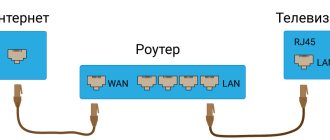Today it is difficult to imagine a home without a TV. The variety in the television equipment market is great enough that sometimes buyers get lost and cannot choose just one thing. Every year, manufacturers add more and more features and updated capabilities. Nowadays, TV is not just a means of watching TV channels, but a whole world of multimedia. In addition to the functional aspect, consumers are wondering which TV is better - LED or LCD. This article will analyze the features of each, as well as analyze the functions of modern TV.
Functions of a modern TV
Aware means armed. When choosing a television receiver, it is important to know what exactly you expect from it. It is difficult to keep up with developers and be in the trend of the latest technologies. Let's figure out together what characteristics and functions the new television equipment has.
- The first thing that is important to consider is the screen resolution. The image quality on the device directly depends on this parameter. The most common formats at the moment are HD Ready, Full HD and Ultra HD.
- The next important characteristic is sound. Most inexpensive models have 2.0 type acoustics (stereo speakers), but you shouldn’t expect a “wow” effect from it. If you really want to get decent sound transmission, it would be a good idea to consider models that use the 2.1 format. It differs from the first one in the presence of a subwoofer, which provides good bass sound.
- In times of digital television, an important component of the unit is the presence of a built-in DVB-T2 tuner. This will allow you to view channels in excellent quality, without special set-top boxes and decoders.
- Communication and data exchange tools. Most TVs are integrated by the manufacturer with a sufficient number of ports for full operation. Only their number matters. The more inputs, the more additional gadgets you can connect to your TV.
And another feature worth noting is access to data exchange with other multimedia devices.
Premium-level TVs should be equipped with such technical highlights as:
- DLNA, gives access to uniting all Hi-Tech devices into one LAN network
- Wi-Fi Direct, or as it is also called Miracast, is a function that provides the ability to transfer multimedia files without creating a local network.
- WiDi, a useful feature for broadcasting images from a mobile phone to TV. To do this, you will need to connect the devices using wi-fi.
- NFC technology makes it easier and faster to connect your TV to other devices
- Of course, such a necessary function as SmartTV will also come in handy. It completely changes the meaning of the blue screen, turning it into a kind of computer system with access to the World Wide Web.
- Not the most important, but very nice feature is 3D. Today, there are 2 technologies for creating a three-dimensional image: active and passive. Active 3D is superior in picture quality, and passive development is convenient and hassle-free use.
Having learned about the advantages of new products, you can return to our main topic - LCD (LCD) or LED TV - which is better. To do this, we will analyze each of them in detail.
How does it work and what does it give?
Now that you're up to date with LED technology and what it means, it's time to understand how it compares to plasma or LCD TVs. We won’t load you with a lot of technical information, because this is still the same LCD TV, in which the backlight has changed. But we still note the main characteristics of LEDs. After all, they are designed to take image quality to a new level!
- You've probably noticed that LEDs are much brighter than regular bulbs. This property is one of the key ones, since a powerful backlight ensures high brightness of the screen, which means that colors will be visible in all their glory even in a room with bright light, which cannot be said about plasma or LCD.
- The abandonment of massive CCFL backlight made it possible to make the TV body amazingly thin: diodes are also good because they do not take up much space. Thus, the thickness of the LED TV body can be less than a centimeter, depending on the type of technology used. This technique, of course, looks super modern.
- When was the last time you changed an LED? Most likely, if this happened at all in your life, it was quite a long time ago when they were not so advanced and widely used. Now their service life is measured in decades, and the likelihood that it will burn out or overheat tends to zero.
- This may not make a big difference, but an LED TV consumes less electricity than an LCD or plasma, since the LEDs themselves need many times less power. If the TV in your house is always on, you may be able to slightly reduce the amount on your electricity bill.
- This does not have any impact on picture quality, but it is nice to know that by using diodes you can contribute to the environment. They do not use aerosols or mercury, and do not require special disposal. Truly modern technologies must be environmentally friendly!
We recommend: How to choose a good electric meat grinder for your home?
Sounds good: improved image quality, energy savings, low chance of failure. But which LED TV to choose?
By the way
If plasma, although not without its drawbacks, was considered more advanced than conventional LCD TVs, then LED LCD panels wiped its nose: their image quality is almost as good, and they consume much less energy, and most importantly, they are cheaper.
What is LCD TV
LCD or so-called LCD monitors are two transparent electrode plates with liquid crystals between them. Such a system cannot emit light on its own; a cold cathode fluorescent lamp helps it do this. Longitudinal backlight beams are located behind the liquid crystal matrix, and are activated by applying electric current to them.
Why LED?
LED is an acronym used to shorten the phrase Light Emitting Diode, or good old LED in Russian. The companies that were the first to produce LED models did not translate the name given to such TVs: apparently, “LED TV” does not sound intriguing enough. But how are LEDs used in the new generation of TVs?
LED TV... Sounds like something very complex and high-tech! But to understand what it is, it’s enough to look around. What kind of lamps are in your flashlight? And what kind of lighting in the kitchen? Remember how LED headlights dazzle oncoming cars and how brightly the New Year's garlands burn. The era of incandescent lamps has given way to the era of fluorescent lamps, but that is already behind us: wherever it comes to lighting, LEDs command the parade.
So they decided to use them in TVs instead of cold cathode fluorescent lamps, which were used in LCD TVs of the previous generation. Exclusively for illumination. Did you think that the image itself would be made from LEDs? Oh, these are technologies of the future, and OLED screens, although they exist, are still imperfect and cost crazy amounts of money.
Features of LED TVs
In essence, LED TV is a modernized LCD display, which is based on a matrix of the same type as the previous model.
Unlike LCD, here the crystals are illuminated by LEDs. In turn, these types of lighting are divided into two more:
- EdgeLed. In this type of backlight, LEDs are placed on the sides of the screen, directing the light to the end of the panel. For uniform illumination, diffusers are used, and installed reflectors compensate for light losses.
- DirectLed. It is considered better than the first option. Here the LEDs are placed on the back of the panel, covering the entire area. To improve picture quality, diffusers and a reflector are also used.
In addition to the different arrangement of diodes, ice backlight can be white or colored:
- White is mainly used for side lighting. It is based on a blue light source.
- Multi-colored ones are used in direct LED. It conveys all color shades much better.
What is the difference between LCD and LED
As you can understand from what has been written, the main difference between LCD and LED TVs is the production technology. To understand what type of LCD panel to purchase, it is worth considering the following factors:
- Image. LED TVs are far ahead in this parameter. Their picture has better brightness, contrast and color rendition.
- Environmental friendliness. Due to the absence of mercury lamps, ice models win according to this criterion
- Energy efficiency. It is known that diodes consume significantly less electricity. But if you only use the TV in the evenings, the difference in energy consumption will be almost unnoticeable.
- Service life. LCD lamps burn out faster, while RGB diodes maintain accurate color reproduction much longer.
- Appearance. By their design, ice looks more attractive. They are much thinner and lighter
- Practicality. The new ones have more useful interfaces and connectors for interacting with other digital devices.
- The presence of smart devices is also more common among representatives from the LED segment.
- In addition to the variety of sizes, LEDs have two types of screens: straight and curved.
- If you plan to place the TV on the wall, then it is better to choose ice. It fits closer to the wall and looks more aesthetically pleasing.
Judging by these parameters, it can be argued that modern LED TVs are much better than their predecessors. Thanks to technological progress, they meet the wishes of the visitor.
Which is better - LCD or LED TV
Today it is difficult to imagine a home without a TV. The variety in the television equipment market is great enough that sometimes buyers get lost and cannot choose just one thing. Every year, manufacturers add more and more features and updated capabilities. Nowadays, TV is not just a means of watching TV channels, but a whole world of multimedia. In addition to the functional aspect, consumers are wondering which TV is better - LED or LCD. This article will analyze the features of each, as well as analyze the functions of modern TV.
Functions of a modern TV
Aware means armed. When choosing a television receiver, it is important to know what exactly you expect from it. It is difficult to keep up with developers and be in the trend of the latest technologies. Let's figure out together what characteristics and functions the new television equipment has.
- The first thing that is important to consider is the screen resolution. The image quality on the device directly depends on this parameter. The most common formats at the moment are HD Ready, Full HD and Ultra HD.
- The next important characteristic is sound. Most inexpensive models have 2.0 type acoustics (stereo speakers), but you shouldn’t expect a “wow” effect from it. If you really want to get decent sound transmission, it would be a good idea to consider models that use the 2.1 format. It differs from the first one in the presence of a subwoofer, which provides good bass sound.
- In times of digital television, an important component of the unit is the presence of a built-in DVB-T2 tuner. This will allow you to view channels in excellent quality, without special set-top boxes and decoders.
- Communication and data exchange tools. Most TVs are integrated by the manufacturer with a sufficient number of ports for full operation. Only their number matters. The more inputs, the more additional gadgets you can connect to your TV.
And another feature worth noting is access to data exchange with other multimedia devices.
Premium-level TVs should be equipped with such technical highlights as:
- DLNA, gives access to uniting all Hi-Tech devices into one LAN network
- Wi-Fi Direct, or as it is also called Miracast, is a function that provides the ability to transfer multimedia files without creating a local network.
- WiDi, a useful feature for broadcasting images from a mobile phone to TV. To do this, you will need to connect the devices using wi-fi.
- NFC technology makes it easier and faster to connect your TV to other devices
- Of course, such a necessary function as SmartTV will also come in handy. It completely changes the meaning of the blue screen, turning it into a kind of computer system with access to the World Wide Web.
- Not the most important, but very nice feature is 3D. Today, there are 2 technologies for creating a three-dimensional image: active and passive. Active 3D is superior in picture quality, and passive development is convenient and hassle-free use.
Having learned about the advantages of new products, you can return to our main topic - LCD (LCD) or LED TV - which is better. To do this, we will analyze each of them in detail.
What is LCD TV
LCD or so-called LCD monitors are two transparent electrode plates with liquid crystals between them. Such a system cannot emit light on its own; a cold cathode fluorescent lamp helps it do this. Longitudinal backlight beams are located behind the liquid crystal matrix, and are activated by applying electric current to them.
Features of LED TVs
In essence, LED TV is a modernized LCD display, which is based on a matrix of the same type as the previous model.
Unlike LCD, here the crystals are illuminated by LEDs. In turn, these types of lighting are divided into two more:
- EdgeLed. In this type of backlight, LEDs are placed on the sides of the screen, directing the light to the end of the panel. For uniform illumination, diffusers are used, and installed reflectors compensate for light losses.
- DirectLed. It is considered better than the first option. Here the LEDs are placed on the back of the panel, covering the entire area. To improve picture quality, diffusers and a reflector are also used.
In addition to the different arrangement of diodes, ice backlight can be white or colored:
- White is mainly used for side lighting. It is based on a blue light source.
- Multi-colored ones are used in direct LED. It conveys all color shades much better.
What is the difference between LCD and LED
As you can understand from what has been written, the main difference between LCD and LED TVs is the production technology. To understand what type of LCD panel to purchase, it is worth considering the following factors:
- Image. LED TVs are far ahead in this parameter. Their picture has better brightness, contrast and color rendition.
- Environmental friendliness. Due to the absence of mercury lamps, ice models win according to this criterion
- Energy efficiency. It is known that diodes consume significantly less electricity. But if you only use the TV in the evenings, the difference in energy consumption will be almost unnoticeable.
- Service life. LCD lamps burn out faster, while RGB diodes maintain accurate color reproduction much longer.
- Appearance. By their design, ice looks more attractive. They are much thinner and lighter
- Practicality. The new ones have more useful interfaces and connectors for interacting with other digital devices.
- The presence of smart devices is also more common among representatives from the LED segment.
- In addition to the variety of sizes, LEDs have two types of screens: straight and curved.
- If you plan to place the TV on the wall, then it is better to choose ice. It fits closer to the wall and looks more aesthetically pleasing.
Judging by these parameters, it can be argued that modern LED TVs are much better than their predecessors. Thanks to technological progress, they meet the wishes of the visitor.
Which TV to choose
When choosing a TV, you should not focus only on the backlight; there are other criteria that affect the image quality. These include resolution, video processor type, and the presence of additional parameter settings functions.
Reviews and opinions of buyers on the Internet are divided. Some users are quite satisfied with the LCD; this choice is justified mainly by its low cost. But most consumers consider modern LEDs to be the best. They note the good quality of the picture, functionality and sophisticated, fashionable design. We wish you to make the right choice and purchase a good TV that will delight you for many years!
Which TV to choose
When choosing a TV, you should not focus only on the backlight; there are other criteria that affect the image quality. These include resolution, video processor type, and the presence of additional parameter settings functions.
Reviews and opinions of buyers on the Internet are divided. Some users are quite satisfied with the LCD; this choice is justified mainly by its low cost. But most consumers consider modern LEDs to be the best. They note the good quality of the picture, functionality and sophisticated, fashionable design. We wish you to make the right choice and purchase a good TV that will delight you for many years!











